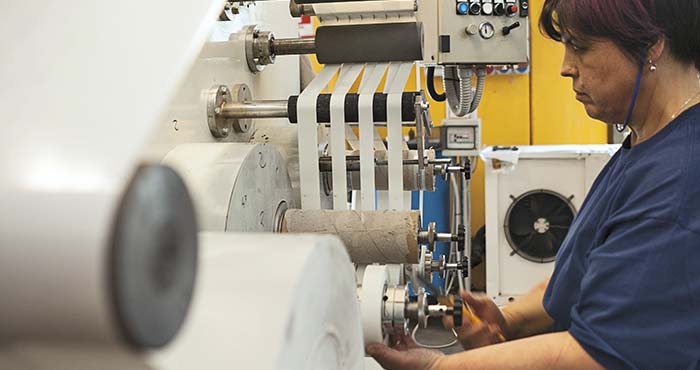
Adhesive Coating


At Filmcutter, we offer adhesive coating processes, also known as adhesivization. This process was developed to meet the company's need to supply the electric machinery market with self-produced adhesive tapes, aligning with our core business development.
With the introduction of new 2300 mm light equipment, Filmcutter can now apply various types of water-based or solvent-based adhesives to a wide range of materials, including films, papers, cardboards, fabrics, and many more. The adhesivization is performed using Mayer bar or blade technologies, applying the adhesive directly onto the material or transferring it using a sacrificial silicone paper or film.
Additionally, Filmcutter has a small 300 mm light hotmelt coater. The resulting products are adhesive or double-sided tapes that can be supplied with an internal peelable liner to protect the adhesive layer.
Thanks to close collaboration with our suppliers and chemical research laboratories, we can develop customized solutions for our clients, meeting the diverse demands of various application sectors.
The Adhesivization Process
Adhesivization is a fundamental process in modern industry, involving the application of adhesive layers on surfaces to create stable and durable bonds. This process is widely used across various sectors, including manufacturing, electronics, automotive, aerospace, and more. Adhesives are chemical substances that enable the creation of permanent or temporary bonds between two or more materials, offering numerous advantages over traditional fastening methods like screws, welding, or nails.
One of the main advantages of adhesive coating is the ability to join different materials, including metals, plastics, glass, ceramics, and composites, without the need to drill or damage the surfaces. This allows for the creation of lightweight, flexible, and aesthetically pleasing assemblies, reducing production costs and simplifying the assembly process. Additionally, adhesives can evenly distribute mechanical stress along the interface between materials, improving the overall strength of the assembly and reducing the risk of cracks or damage.
Another important feature is the ability to create waterproof and weather-resistant joints. Modern adhesives are formulated to withstand exposure to moisture, temperature, UV rays, and other aggressive environmental agents, ensuring the durability and reliability of assembled structures even in extreme conditions. This weather resistance makes adhesive coating particularly suitable for outdoor applications or in corrosive environments such as marine or industrial settings.
Main Benefits
Furthermore, adhesivization offers greater design flexibility and better load distribution compared to traditional fastening methods. Adhesive coating can be applied in small areas or along continuous lines, allowing for uniform load distribution and greater overall assembly strength. This design flexibility enables the creation of lighter, stronger, and more efficient structures, reducing production times and improving the overall performance of the final product.
Another significant advantage is the ability to reduce vibrations and noise in assembled structures. Adhesive coatings can absorb vibrations and reduce sound transmission through joints, enhancing the comfort and safety of end users. This vibration damping capability is particularly important in sectors such as automotive, aerospace, and electronics, where vibrations and noise can affect the performance and longevity of components.
Finally, adhesivization offers greater fatigue resistance and better stress distribution compared to traditional fastening methods. Adhesivization technologies can adapt to variations in load and temperature conditions, reducing the risk of premature cracking or failure. This increased fatigue resistance makes adhesives particularly suitable for applications subject to dynamic or cyclic stresses, such as vehicles, aircraft, or structures subjected to variable loads over time.
In conclusion, adhesivization is an essential process in modern industry, offering numerous advantages in terms of strength, durability, design flexibility, and overall performance. Adhesives are widely used across various sectors to join different materials, create waterproof and weather-resistant joints, reduce vibrations and noise, improve fatigue resistance, and optimize the weight and performance of assembled structures. With the continuous innovation and development of new adhesive materials and technologies, adhesive coating will continue to play a crucial role in enhancing the efficiency and quality of industrial and technological products.

